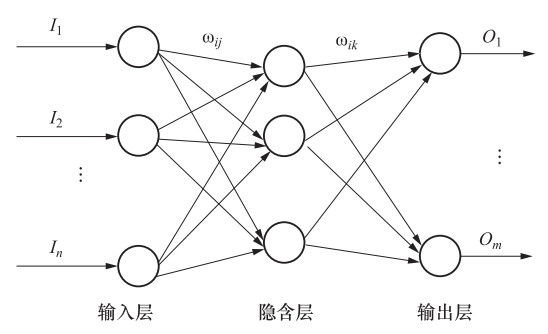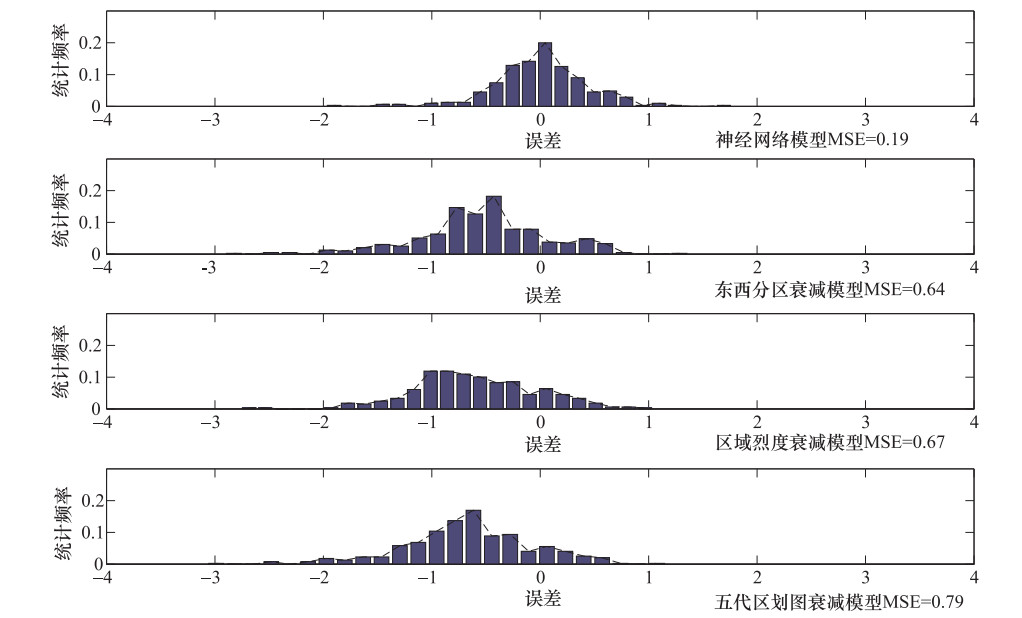Application Research of Genetic Neural Network in Seismic Intensity Evaluation
-
摘要: 准确判定极震区烈度是震后应急工作高效开展的重要基础。收集1966—2017年发生在中国大陆地区MS 5.0以上有详细烈度记录的地震事件322例,选取与极震区烈度有关的7个因子进行主成分分析,将提取的主成分确定为BP神经网络的输入,极震区烈度为输出,在遗传算法优化的基础上,构建用于极震区烈度预测的BP神经网络模型。结果显示,与传统模型相比,神经网络模型在预测误差分布、精度和预测结果正确率等方面都具有明显的优越性。Abstract: Accurate and rapid determination of seismic intensity in meizoseismal area is an important basis for efficient post-earthquake emergency work. In this paper, 322 earthquake events of MS 5.0 or more occurred in the mainland of China are collected. Seven factors related to the intensity of the epicenter are selected and principal component analysis is carried out. The extracted principal component is determined as the input of BP neural network when the intensity of the epicenter is the output of the network. Based on the optimization of genetic algorithm, a model for intensity prediction in epicentral area is constructed. Finally, the new model is compared with three traditional ones, and the results show that the neural network model constructed in this paper has obvious advantages in prediction error distribution, accuracy, as well as correctness of prediction.
-
表 1 各成分贡献率及累积贡献率
Table 1. Contribution rate and cumulating contribution rate of each component
成分 特征值 贡献率/% 累积贡献率/% Q1 2.0680 29.5430 29.54 Q2 1.3824 19.7490 49.29 Q3 0.9396 13.4230 62.72 Q4 0.8565 12.2350 74.95 Q5 0.7146 10.2090 85.15 Q6 0.6861 9.8021 94.96 Q7 0.3528 5.0398 100.00 表 2 选取的6个主成分因子载荷系数
Table 2. Lood factor of six principal components selected
指标 Q1 Q2 Q3 Q4 Q5 Q6 χ1 0.16412 0.41910 -0.75764 0.17834 0.41099 -0.13618 χ2 -0.00751 0.59456 0.44545 -0.31087 0.45350 0.36166 χ3 0.60009 -0.00592 0.09782 -0.17487 0.10146 -0.11982 χ4 0.37214 -0.15226 0.19900 0.76209 0.16748 0.42389 χ5 0.40596 0.30893 -0.21196 -0.17952 -0.68365 0.40464 χ6 -0.54154 0.10111 -0.21863 0.14641 -0.08768 0.52548 χ7 0.12785 -0.58478 -0.29267 -0.45445 0.33469 0.46558 表 3 极震区烈度神经网络仿真结果
Table 3. Neural network simulation of maximum intensity
地震名称 发震时间 极震区烈度/度 实际调查结果 神经网络仿真结果 新疆塔什库尔干5.5级 2017/05/11 7 7 内蒙古阿拉善左旗5.0级 2017/06/03 6 6 四川九寨沟7.0级 2017/08/08 9 9 新疆精河6.6级 2017/08/09 8 8 陕西宁强5.3级 2017/09/12 6 6 四川省青川县5.4级 2017/09/30 6 6 西藏米林6.9级 2017/11/18 8 8 重庆武隆5.0级 2017/11/23 6 6 吉林松原5.7级 2018/05/28 7 6 新疆伽师5.5级 2018/09/04 7 7 表 4 四种模型的预测结果
Table 4. Prediction results of four models
项目/% 神经网络模型 东西分区烈度衰减模型 区域烈度衰减模型 五代区划图烈度衰减模型 准确率 80 66 61 62 大于实际值 11 19 22 24 小于实际值 9 15 17 14 -
陈鲲, 俞言祥, 高孟潭, 2010. 考虑场地效应的ShakeMap系统研究. 中国地震, 26(1): 92—102. doi: 10.3969/j.issn.1001-4683.2010.01.009 胡旺, 张建, 陈维锋等, 2018. 基于神经网络的烈度衰减融合模型研究. 电子科技大学学报, 47(2): 224—229. doi: 10.3969/j.issn.1001-0548.2018.02.010 雷建成, 高孟潭, 俞言祥, 2006. 西南地区近代地震的震中烈度与有感半径的统计研究. 震灾防御技术, 1(2): 137—145. doi: 10.3969/j.issn.1673-5722.2006.02.007 雷建成, 高孟潭, 俞言祥, 2007. 四川及邻区地震动衰减关系. 地震学报, 29(5): 500—511. doi: 10.3321/j.issn:0253-3782.2007.05.007 刘军, 吕红山, 温和平等, 2014. 稳健回归模型在地震烈度衰减关系中的应用. 地震工程学报, 36(1): 114—119. doi: 10.3969/j.issn.1000-0844.2014.01.0114 马骏驰, 窦远明, 苏经宇等, 2005. 东南沿海地区震级与震中烈度的统计关系. 世界地震工程, 21(4): 119—122. doi: 10.3969/j.issn.1007-6069.2005.04.020 聂高众, 徐敬海, 2018. 基于震源深度的极震区烈度评估模型. 地震地质, 40(3): 611—621. doi: 10.3969/j.issn.0253-4967.2018.03.008 钱枫林, 崔健, 2013. BP神经网络模型在应急需求预测中的应用——以地震伤亡人数预测为. 中国安全科学学报, 23(4): 20—25. https://www.cnki.com.cn/Article/CJFDTOTAL-ZAQK201304005.htm 韶丹, 孙哲, 田勤虎, 2018a. 联合钻孔资料及地形数据估算宝鸡地区VS30. 地震地磁观测与研究, 39(1): 117—122. https://www.cnki.com.cn/Article/CJFDTOTAL-DZGJ201801020.htm 韶丹, 孙哲, 田勤虎等, 2018b. 中国大陆历史地震烈度统计. 地震地磁观测与研究, 39(4): 135—140. https://www.cnki.com.cn/Article/CJFDTOTAL-DZGJ201804017.htm 王鹤, 刘梦琳, 席振铢等, 2018. 基于遗传神经网络的大地电磁反演. 地球物理学报, 61(4): 1563—1575. https://www.cnki.com.cn/Article/CJFDTOTAL-DQWX201804030.htm 汪素云, 俞言祥, 高阿甲等, 2000. 中国分区地震动衰减关系的确定. 中国地震, 16(2): 99—106. https://www.cnki.com.cn/Article/CJFDTOTAL-ZGZD200002000.htm 王晓军, 文毅, 鲁权等, 2012. 陕西分区烈度衰减关系研究. 灾害学, 27(4): 98—102, 113. https://www.cnki.com.cn/Article/CJFDTOTAL-ZHXU201204023.htm 肖恭伟, 欧吉坤, 刘国林等, 2018. 基于改进的BP神经网络构建区域精密对流层延迟模型. 地球物理学报, 61(8): 3139—3148. https://www.cnki.com.cn/Article/CJFDTOTAL-DQWX201808004.htm 许卫晓, 杨伟松, 孙景江等, 2016. 震中烈度与震级和震源深度经验关系的统计回归分析. 自然灾害学报, 25(2): 139—145. https://www.cnki.com.cn/Article/CJFDTOTAL-ZRZH201602016.htm 赵士达, 张楠, 张斯文等, 2016. 基于LM-BP神经网络的地震直接经济损失快速评估方法研究. 地震研究, 39(3): 500—506. https://www.cnki.com.cn/Article/CJFDTOTAL-DZYJ201603020.htm 周中红, 何少林, 陈文凯等, 2011. 甘肃地区地震烈度影响场计算模型参数的改进研究与应用. 震灾防御技术, 6(2): 180—189. http://zzfy.eq-j.cn/zzfyjs/ch/reader/view_abstract.aspx?flag=1&file_no=20110210&journal_id=zzfyjs 朱林, 姜立新, 杨天青, 2015. BP神经网络模型在地震应急人员伤亡评估中的应用. 自然灾害学报, 24(6): 33—41. https://www.cnki.com.cn/Article/CJFDTOTAL-ZRZH201506004.htm Allen T. I., Wald D. J., 2007. Topographic slope as a proxy for seismic site-conditions (VS30) and amplification around the globe. Open-File Report 2007-1357, Reston, Virginia: U.S. Geological Survey. Wald D. J., Quitoriano V., Heaton T. H., et al., 1999. Trinet "ShakeMaps": rapid generation of peak ground motion and intensity maps for earthquakes in southern California. Earthquake Spectra, 15(3): 537—556. http://scitation.aip.org/getabs/servlet/GetabsServlet?prog=normal&id=EASPEF000015000003000537000001&idtype=cvips&gifs=Yes -




 下载:
下载:



